|
|
 |
|
Calanoida ( Order ) |
|
|
|
Metridinidae ( Family ) |
|
|
|
Gaussia ( Genus ) |
|
|
| |
Gaussia princeps (T. Scott, 1894) (F,M) | |
| | | | | | | Syn.: | Pleuromma princeps T. Scott, 1894 b (p.42, Descr.M, figs.M);
Metridia scotti Giesbrecht & Schmeil, 1898 (p.107);
no Sewell, 1913 (p.354);
Gaussia melanotica Wolfenden, 1905 a (pl.2, figs.1-5);
Gaussia Scotti Wolfenden, 1905 a (p.5); 1911 (p.290, figs.F,M); Lysholm & al., 1945 (p.32); Saraswathy, 1973 a (p.191, figs.F,M); Stephen, 2007 [Data sheets of NIO, Kochi, India (on line)].
Female
Metridia atra Esterly, 1906 a (p.70, Juv.5: F); C.B. Wilson, 1950 (p.263, Rem.); Guérédrat,1969 a (p.362);
no G. princeps : Sewell, 1932 (p.270, figs.F,M); 1947 (p.173); ? Tanaka & Omori, 1967 (p.251) | | | | Ref.: | | | Davis, 1949 (p.50, figs.F); C.B. Wilson, 1950 (p.235, figs.F,M); Brodsky, 1950 (1967) (part., p.312, figs. NP: F,M, non figs. F,M: Ind. Oc, Rem.); Vervoort, 1965 (p.103, Rem.); Owre & Foyo, 1967 (p.74, figs.F,M); Barnes & Case, 1972 (p.53, bioluminescence); Gardner & Szabo, 1982 (p.348, figs.F,M); Björnberg & Campaner, 1988 (p.351, 354, fig.F, Rem.); Hulsemann, 1988 (p.188, Rem.); Baessa-de-Aguiar, 1989 (1992) (p.117, figs.F,M); Bowlby & Case, 1991 (p.440, bioluminescence); Soh & al., 1998 (p.171, Redescr.F,M, figs.F,M, juv., fig.7: carte, Rem.); Bradford-Grieve & al., 1999 (p.884, 948, figs.F,M); Bradford-Grieve,1999 b (p.111, figs.F,M, Rem., figs.177, 192); Vives & Shmeleva, 2007 (p.3, figs.F,M, Rem.); Vives & Shmeleva, 2007 (p.357, figs.F,M, Rem.); Suarez-Morales, 2007 (p.34 , figs.M, tabl.2, 3, 4, Rem.); Mercier & al., 2013 (p.760, neural ultrastructure) | 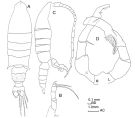 issued from : J.M. Bradford-Grieve in The Marine Fauna of New Zealand: Pelagic Calanoid Copepoda. National Institute of Water and Atmospheric Research (NIWA). NIWA Biodiversity Memoir, 111, 1999. [p.111, Fig.74]. Female (from 39°49.9'S, 178°26'E): A, habitus (dorsal); B, P5. Male: C, habitus (right lateral side); D, P5 (L = left leg; R = right leg). Female characteristics: - Spinous prolongations of posterolateral corners of last thoracic segment divergent. - Proximal part of genital segment asymmetrically inflated, with a prominent curved process usually on right side. - Blunt processes on caudal rami are prominent. - Penultimate segment of P5 as broad as long. Male characteristics: - Processes on caudal rami as in female; - Proximally directed spine on segment 3 of left P5 blunt, short and stumpy; terminal segment of right leg with a prominent undulating border, and 4 setae ; the distance between setae 1 and 2 and 2 and 3 almost equal. Remarks: In the Southwest Pacific males right P5 terminal segment with the distance between spines 1 and 2 (numbering from proximal part of segment) is almost twice that of the distance between spines 2 and 3; spines 3 and 4 much shorter than spines 1 and 2.
|
 issued from : H.Y. Soh, S. Ohtsuka, H. Imabayashi & S. Sawamoto inSpecies Diversity, 1998, 3. [p.173, Fig.1]. Female (from Suruga Bay): A, habitus (dorsal); B, idem (lateral left side); C, forehead (lateral); D, genital compound somite (dorsal); E, idem (lateral); F, idem (ventral. c: copulatory pore; cd: copulatory duct; g, gonopore.
|
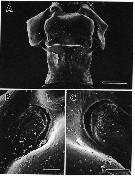 issued from : H.Y. Soh, S. Ohtsuka, H. Imabayashi & S. Sawamoto inSpecies Diversity, 1998, 3. [p.143, Fig.2]. Female: scanning electon microscope micrographs of genital compound somite; Aventral (copulatiory pores damaged); B, right gonopore; C, left gonopore. Scale bars = 0.3 mm (A); 0.05 mm (B,C).
|
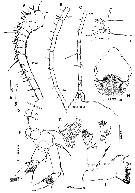 issued from : H.Y. Soh, S. Ohtsuka, H. Imabayashi & S. Sawamoto inSpecies Diversity, 1998, 3. [p.175, Fig.3]. Female: A, left A1 (segments I-XIV); B, idem (segments XV-XX); C, idem (segments XXI-XXVIII); D, idem (segments XIV-XV); E, idem (segments XXVII-XXVIII); F, A2; G, 2nd endopodal segment of A2; H, labrum and paragnaths; I, Md. Arrowheads indicate gland openings.
|
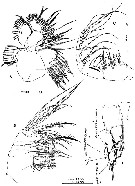 issued from : H.Y. Soh, S. Ohtsuka, H. Imabayashi & S. Sawamoto inSpecies Diversity, 1998, 3. [p.177, Fig.4]. Female: A, Mx1; B, Mx2; C, Mxp; D, P1 (anterior). Arrowheads indicate gland openings.
|
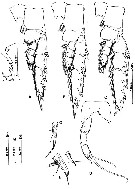 issued from : H.Y. Soh, S. Ohtsuka, H. Imabayashi & S. Sawamoto inSpecies Diversity, 1998, 3. [p.178, Fig.5]. Female (from Suruga Bay): A, P2 (anterior); B, P3 (anterior); C, P4 (anterior); D, P5 (posterior). Female (from the Indian Ocean): E, distal seta on 3rd exopodal segment of right P5. Gaussia sewelli Saraswathy, 1973, Female (from the Indian Ocean): G, distal seta on 3rd exopodal segment of right P5. Arrowheads indicate gland openings.
|
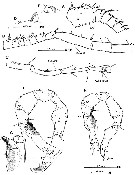 issued from : H.Y. Soh, S. Ohtsuka, H. Imabayashi & S. Sawamoto inSpecies Diversity, 1998, 3. [p.180, Fig.6]. Male: (from the Indian Ocean): A, A1 (segments I-VIII); B, idem (segments IX-XIX); C, idem (segments XX-XXVIII); D, E (holotype), anterior part of A1 segment XIV; F, P5 (posterior); G, medial process on 2nd exopodal segment of left P5 (anterior). Gaussia sewelli Saraswathy, 1973 (from the Indian Ocean) Male: H, P5 (posterior; distal two exopodal segments of right P5 torted). Arrowheads indicate inner process proximally directed on 2nd exopodal segment. p: process. s: spinule.
|
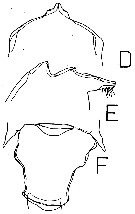 issued from : T.K.S. Björnberg & A.F. Campaner in Hydrobiomogia, 1988, 167/168. [p.352, Figs. D, E, F]. Female (from Chile): D, forehead (dorsal); E, idem (lateral); F, metasomal corners and genital segment (dorsal).
|
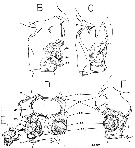 issued from : T.K.S. Björnberg & A.F. Campaner in Hydrobiomogia, 1988, 167/168. [p.353, Figs.B-F]. Female: B, genital segment with attached couplers (lateral right side); D, idem (ventral; E, right coupler with spermatophore after removal of filling material); C, genital segment (lateral right side; another specimen).
|
 issued from : R.N. Wolfenden in Die Marinen Copepoden der Deutschen Südpolar-Expedition 1901-1903, 1911. [Pl.XXXIII, Fig.4]. As Gaussia scotti. Female: 4 habitus (dorsal).
|
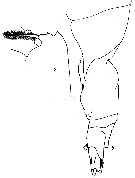 issued from : R.N. Wolfenden in Die Marinen Copepoden der Deutschen Südpolar-Expedition 1901-1903, 1911. [Pl.XXXIII, Fig.5, 8]]. As Gaussia scotti. Female: 5, last thoracic segment and urosome (lateral, left side); 8, forehead (lateral).
|
 issued from : R.N. Wolfenden in Die Marinen Copepoden der Deutschen Südpolar-Expedition 1901-1903, 1911. [Pl.XXXIII, Figs.9-12]. As Gaussia scotti. Female: 9, P2; 10, P3 (distal segment of exopod); 11, P4 (distal segment of exopod); 12, P5.
|
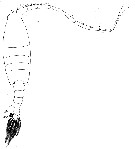 issued from : R.N. Wolfenden in Die Marinen Copepoden der Deutschen Südpolar-Expedition 1901-1903, 1911. [Pl.XXXIII, Fig.3]. As Gaussia scotti. Male: 3, habitus (dorsal).:
|
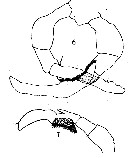 issued from : R.N. Wolfenden in Die Marinen Copepoden der Deutschen Südpolar-Expedition 1901-1903, 1911. [Pl.XXXIII, Figs.6-7]. As Gaussia scotti. Male: 6, P5; 7, right P5.
|
 issued from : E. Suarez-Morales in Zootaxa, 2007, 1621. [p.35, Fig.1]. Male (from W Caribbean): A-B, habitus (lateral and dorsal, respectively); C, forehead lateral; (showing frontal process and depression); D, 5th pedigerous and 1st urosomites (dorsal); E, anal somite and caudal rami (dorsal); F, same (lateral). Scale bars: 3 mm (A, B); 0.7 mm (C-F)
|
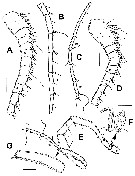 issued from : E. Suarez-Morales in Zootaxa, 2007, 1621. [p.36, Fig.2]. Male: A, left A1 (segments 1-10); B, same (segments 11-16); C, same (segments 17-23); D, right A1 (segments 1-10); E, same (segments 11-20); F, same (detail of modified seta and aesthetascs); G, detail of segment 17 and distal acute process (position of integumental pores indicated by solid circles. Scale bars: 0.7 mm (A-E); 0.05 mm (F); 0.35 mm (G).
|
 issued from : E. Suarez-Morales in Zootaxa, 2007, 1621. [p.37, Fig.3]. Male: A, A2; B, Md (mandibular palp); C, Md (mandibular blade showing detail of teeth and blade ornamentation); D, Mx2; E, Mxp; E, P1; G, rostal area (ventral). Position of integumental pores indicated by solid circles. Scale bars: 0.7 mm (A, B-G); 0.2 mm (C).
|
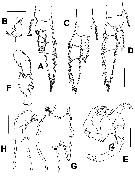 issued from : E. Suarez-Morales in Zootaxa, 2007, 1621. [p.38, Fig.4]. Male: A, P2; B, detail of hook-like and spiniform processes on 1st endopodal segment of P2; C, P3; D, P4; E, P5 (anterior); F, basipod and exopod of left P5 (lateral view); G, detail of processes of 2nd exopodal segment of left P5; H, detail of distal exopodal segment of right P5 (showing ornamentation). Position of integumental pores indicated by solid sircles. Scale bars: 0.7 mm (A, C-E, H); 0.3 mm (B, F, G).
|
 issued from : E. Suarez-Morales in Zootaxa, 2007, 1621. [p.41, Table 2]. Male: Comparison of pore number of right A1 of Gaussia princeps from the Caribbean (GpC), the Indian Ocean (Gpl) from Soh & al., 1998, and G. sewelli (GsI) from Saraswathy & Bradford, 1980 from the Indian Ocean. A1 segments grouped in 3 sectors: 1st segment, segments 2-5, and 6-12. Nota: The number and general distribution of the pores (gland openings) have been found to express important differences between congeners in Gaussia. The Caribbean specimens showed a pore pattern that differs in number with that described from specimens from the Indian Ocean and Japan (Soh & al.,, 1998) on different appendages
|
 issued from : E. Suarez-Morales in Zootaxa, 2007, 1621. [p.42, Table 3]. Male : Comparison of pore number of P5 of from the Caribbean (GpC), the Indian Ocean (Gpl) from Soh & al., 1998, and G. sewelli (GsI) from Saraswathy & Bradford, 1980 from the Indian Ocean.
Cx = coxa; Bp = basipodite; Enp = endopodite; Exp = exopodite; R = right; L = left.
|
 issued from : E. Suarez-Morales in Zootaxa, 2007, 1621. [p.42, Table 3]. Male : Comparison of pore number of P1-P4 of Gaussia princeps from the Caribbean (GpC), the Indian Ocean (Gpl) from Soh & al., 1998, and G. assymmetrica (GaSA) from the south-western Atlantic Ocean (Björnberg & Campaner, 1990), and G. intermedia (GiNP) from the north Pacific (Defaye, 1998)
Cx = coxa; Bp = basipodite; Enp = endopodite; Exp = exopodite.
|
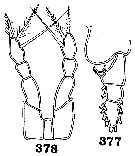 issued from : C.B. Wilson in Bull. U.S. natn Mus., 100, 14 (4). [Pl.25, Figs.377-378]. As Metridia atra. Female (from 13°37'40''N, 120°39'E): 377, endopod of P2; 378, P5.
|
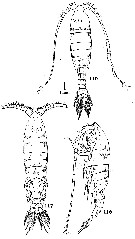 issued from : C.B. Wilson in Bull. U.S. natn Mus., 100, 14 (4). [Pl.11, Figs.117-119]. Female (from Pacific): 117-118, habitus (dorsal and lateral). Male: 119, habitus (dorsal). Nota: The color is very dark, almost black, with the ventral surface of the genital segment a reddish brown.
|
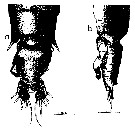 issued from : R. Stephen, 2007 [Data sheets of NIO, Kochi, India (on line)]. After M. Saraswathy, 1973. As Gaussia scotti. Female (from W Indian): a, last thoracic segment and urosome (dorsal). Male: last thoracic segment and urosome (lateral).
|
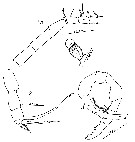 issued from : M. Saraswathy in Handbook to the Intern. zoopl. Coll., Cochin-18, Kerala State, India, 1973. [p.191, Fig.1a, 1b, 2, 3]. As Gaussia scotti. Female (from world-wide): 2, P5. Male: 1a, right A1 (segments 10 to 16); 1b, glandular structure on segment 12); 3, P5. Nota: Proximally directed spine on 3rd segment of P5 blunt, short and stumpy. Terminal segment of right leg with prominent undulating inner border, and 4 setae; distance between 1st and 2nd and 2nd and 3rd setae almost equal.
|
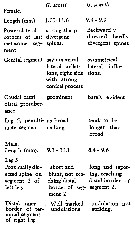 issued from : M. Saraswathy in Handbook to the Intern. zoopl. Coll., Cochin-18, Kerala State, India, 1973. [p.194]. Comparison between G. scotti (= G. princeps) and G. sewelli.
|
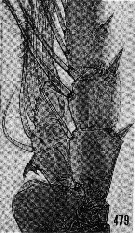 issued from : H.B. Owre & M. Foyo in Fauna Caribaea, 1, Crustacea, 1: Copepoda. Copepods of the Florida Current. 1967. [p.73, Fig.479]. Female: 479, P2.
|
 issued from : H.B. Owre & M. Foyo in Fauna Caribaea, 1, Crustacea, 1: Copepoda. Copepods of the Florida Current. 1967. [p.17, Fig.47]. Female: 47, P5.
|
 issued from : H.B. Owre & M. Foyo in Fauna Caribaea, 1, Crustacea, 1: Copepoda. Copepods of the Florida Current. 1967. [p.20, Fig.74]. Male: 74, P5.
|
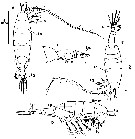 issued from : A.T. Barnes & J.F. Case in J. exp. mar. Biol. Ecol., 1972, 8. [p.59, Fig.3]. Distribution of fluorescent glands, luminescent glands, and luminous pores of adult male and female Gaussia princeps. A: Female; B: Male; C: lateral view of 5th thoracic segment and abdomen of female; D: lateral xiew of female. f: fluorecent gland; l.g.: luminescent gland; l.p.: luminous pore. (modified after Wolfenden, 1911, and Sewell, 1932). Nota: Adult male and female produce bright, extracellular luminescent displays usually coupled with the initiation of rapid swimming. Glands of the head, mandibular palps, urosome, caudal rami, and underlying at least 14 body pores contribute to the luminous response which, in free swimming copepods, is characterized by a sudden discharge to the exterior of luminous blue material that remains at peak intensity for 1-3 sec before undergoing and 80 sec decay as 8 or less discrete, low intensity points of light.
| | | | | Compl. Ref.: | | | Sewell, 1948 (part., p.330, 503, 516, 521, 530, 548, 558, 561); Grice, 1963 a (p.496); Fleminger, 1967 a (tabl.1); Grice & Hulsemann, 1967 (p.17); 1968 (tab.2); Morris, 1970 (p.2301); Lee & al., 1971 (p.1151, 1152); Gueredrat & Friess, 1971 (p.187, fig.1); Roe, 1972 (p.277, tabl.1, tabl.2); Björnberg, 1973 (p.338, 387); Lee & Barnes, 1975 (p.265, lipids); Childress, 1975 (p.787, respiratory rate); 1977 (p.19, pressure, temperature v.s. Oxygen consumption); Vives, 1982 (p.293); Petipa & Borichenko, 1985 (tab.2); Madhupratap & Haridas, 1986 (p.105, tab.1); Lozano Soldevilla & al., 1988 (p.59); Heinrich, 1990 (p.18); Madhupratap & Haridas, 1990 (p.305, fig.3: vertical distribution night/day; fig.7: cluster); Bowlby & Case, 1991 (p.329); 1991 a (p.440); Suarez-Morales & Gasca, 1998 a (p.110); Razouls & al., 2000 (p.343, Appendix); Haury & al., 2000 (p.69, Table 1); Lenz & al., 2000 (p.338); Fields & al., 2002 (p.173); Fernandes, 2008 (p.465, Tabl.2); Galbraith, 2009 (pers. comm.); Inouye & Sahara, 2008 (p.96, luciferase); Takenaka & al., 2012 (p.1669, fig.3, Table 1, bioluminescence); Teuber & al., 2013 (p.1, Table 2, fig.5, respiration rates); in CalCOFI regional list (MDO, Nov. 2013; M. Ohman, comm. pers.); Bode & al., 2015 (p.268, Table 1, chemical components, trophic level, geographic zone) | | | | NZ: | 14 | | |
|
Distribution map of Gaussia princeps by geographical zones
|
| | | | | | | | | 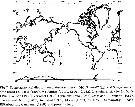 issued from : H.Y. Soh, S. Ohtsuka, H. Imabayashi & S. Sawamoto inSpecies Diversity, 1998, 3. [p.182, Fig.7]. issued from : H.Y. Soh, S. Ohtsuka, H. Imabayashi & S. Sawamoto inSpecies Diversity, 1998, 3. [p.182, Fig.7].
Zoogeographical distribution of Gaussia princeps, G. asymmetrica and G. sewelli. |
 issued from : M. Saraswathy in Handbook to the Intern. zoopl. Coll., Cochin-18, Kerala State, India, 1973. [p.193]. issued from : M. Saraswathy in Handbook to the Intern. zoopl. Coll., Cochin-18, Kerala State, India, 1973. [p.193].
Localities from G. scotti (= G. princeps) (black circle) and G. sewelli (white circle) obtained. |
 issued from : J.J. Childress in Mar. Biol., 1977, 39. [p.23, Fig.3]. issued from : J.J. Childress in Mar. Biol., 1977, 39. [p.23, Fig.3].
Gaussia princeps adult males (in experimental proceedings). Interpolation of data to predict oxygen-consumption in the field.
Solid line shows oxygen-consumption rate based on temperature and pressure considerations only; dotted line takes into account limitations of oxygen uptake by low oxygen and indicates maximum oxygen-consumption possible in the region of this limitation; hatched area represents that part of the metabolic needs which must be accounted for by anaerobic metabolism.
The two scales on the right show the temperature and oxygen characteristics of a typical area (San Clemente Basin, southern California) where the animals are found.
Crosses indicate primary, non-interpolated data, while dots are interpolated points.
Nota: Gaussia princeps is found only below 400 m in the daytime and is present down to the greatest depth sampled (900 m). At night an appreciate fraction of the population migrates to depths shallower than 400 m. Even at night, however, many remain below 400 m. The individuals clearly do not need to migrate above this depth on a daily basis.
This species' consumption was measured at 3.5, 7 and 10°C and 1, 14, 28, 61, 121 and 181 atm of hydrostatic pressure (1 atm corresponds about 10 m of depth).
Hydrostatic pressure is shown to have significant effects on the oxygen-consumption rate at pressures as low as 28 atm.
At all temperature and pressure combinations, the species displays a very low metabolic rate compared to shallow-living copepods.
The critical oxygen partial pressure for this species is shown to be about 10 to 1, mm Hg O2 at 10, 7 and 5.5 °C. This shows a higher oxygen-consumption rate at the nighttime depths and a much lower, partially anaerobic metabolism at the daytime depths. |
 Issued from : M. Madhupratap & P. Haridas in J. Plankton Res., 12 (2). [p.310, Fig.3]. Issued from : M. Madhupratap & P. Haridas in J. Plankton Res., 12 (2). [p.310, Fig.3].
Vertical distribution of calanoid copepod (mean +1 SE), abundance No/100 m3. 16- Gaussia princeps.
Night: shaded, day: unshaded.
Samples collected from 6 stations located off Cochin (India), SE Arabian Sea, November 1983, with a Multiple Closing Plankton Net (mesh aperture 300 µm), in vertical hauls at 4 depth intervalls (0-200, 200-400, 400-600, 600-1000 m). |
| | | | Loc: | | | sub-Antarct. (SE Pacif.) (in Björnberg & Campaner,1988), de Trindade Is., off St. Paul Is., off Gabon, G. of Guinea, Cape Verde Is., off Morocco-Mauritania, Canary Is., Caribbean Sea, Belize, Florida, W Sargasso Sea, S. Cape Hatteras, Indian, Bay of Bengal, Philippines, Japan, S. Hokkaido, off N New Caledonia, New Zealand (E North Island), Pacif. (equatorial), NE Pacif. (Queen Charlotte Is.), Hawaii, off N Hawaii, California (off Monterey Bay, San Pedro, Santa Catalina, San Clemente, Velero and Tanner Basins), NE Easter Is., SW Galapagos, Pacif. (SE tropical), off Juan Fernandez Is., Peru, Chile (N & S, sub-Antarct.) | | | | N: | 47 | | | | Lg.: | | | (10) F: 10,5-10; (16) F: 10,75-10,5; M: 10,4-9,4; (59) F: 12-9; M: 12-9; (94) F: 10.5-11.4 [Indian]; 10.0-10.7 [Atlant.]; 10.0-11.6 [Pacif.]; M: 9.6-10.6 [Indian]; 9.1-10.4 [Atlant.]; 10.1-11.1 [Pacif.]; (199) M: 10,08-9,92; (770) F: 10,47 [Indien]; 10,9 [Japon: Suruga Bay]; M: 9,54 [Indien]; (909) F: 10,45-11,06; M: 9,39-9,85 [N-Z]; (986) M: 10,1; {F: 9,00-12,00; M: 9,00-12,00}
The mean female size is 10.589 mm (n = 19; SD = 0.6712), and the mean male size is 10.058 mm (n = 22; SD = 0.7233). The size ratio (male : female) is about 0.94 (n = 9; SD = 0.0347). | | | | Rem.: | meso-bathy-abyssopelagic. Considered as vetical migrator.
Sampling depth (sub-Antarct.): 0-1200 m.
Compare with figs.1E and 1B the differences between G. princeps and G. asymmetrica in Björnberg & Campaner (1988, p.352).
According to Soh & al. (1998, p.181) the species is distinguished from G. sewelli and G. asymmetrica, by (1) cephalosome anteriorly pointed to stout process, (2) last prosomal somite with almost symmetrical, posteriorly directed processes, (3) genital compound somite of female asymmetrical, with small anterodorsal prominence on right side, (4) proximally directed medial process of 2nd exopodal segment of male left P5 relatively short, not reaching distal border of basis. The number and distribution pattern of gland openings (presumably luminescent) also differ between between congeners. Concerning G. princeps the morphological differences and observations on the gland openings suggest that specimens from the Indo-Pacific region and from the southeastern Pacific might not conspecific.
For Suarez-Morales (2007, p.40) there are some morphological differences between the males from the Indian Ocean, as described by Soh & al. (1998) with respect to the Caribbean male: 1- the shape and size of the accessory spiniform process of the 1st endopodal segment of P2 (this structure is relatively slender, relatively longer in the Caribbean specimen male; 2- the spiniform process on the right A1 segment 17 is more acute and relatively longer in the Caribbean specimen (it stretches well beyond the end of the distal margin of the segment, whereas it barely reaches this margin in the Indian Ocean specimens; 3- the globose setal element with cone-shaped distal protuberance inserted on segment 11 is slightly wider, shorter in the Indian Ocean specimens and the paired aesthetasc is short, slightly longer than the modified seta; in the Caribbean male, the globose seta is more slender and the accompanying aesthetasc is longer. Soh & al. (1998) stated that the shape ofthe bulbous seta on segment 11 of the right male A1 has some range of variation within the species; these differences were also reported by Saraswathy (1973); apparently, this seta has a considerable range of intra- and interspecific variability and its morphology is not consistent within one species of Gaussia. The Caribbean specimens showed a pore pattern that differs in number with that described from specimens from the Indian Ocean and Japan on different appendages.
For R. Stephen (2007, in Data sheets of NIO, Kochi, India, on line) there are conusions in synonymies. | | | Last update : 19/11/2020 | |
|
|
 Any use of this site for a publication will be mentioned with the following reference : Any use of this site for a publication will be mentioned with the following reference :
Razouls C., Desreumaux N., Kouwenberg J. and de Bovée F., 2005-2025. - Biodiversity of Marine Planktonic Copepods (morphology, geographical distribution and biological data). Sorbonne University, CNRS. Available at http://copepodes.obs-banyuls.fr/en [Accessed December 31, 2025] © copyright 2005-2025 Sorbonne University, CNRS
|
|
 |
 |


































